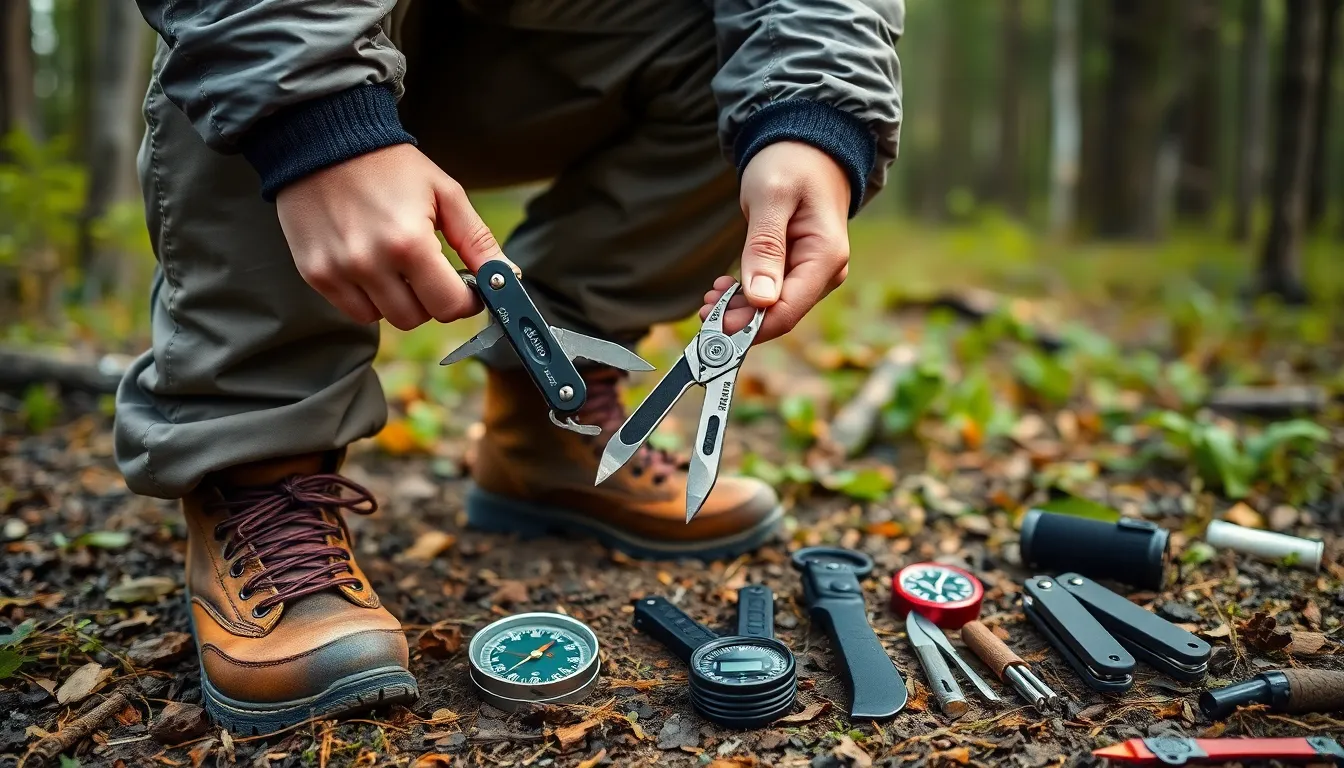Table of Contents
ToggleImagine being lost in the wild, surrounded by towering trees and the sounds of nature—without a clue how to survive. It sounds like a reality show gone wrong, right? But mastering wilderness survival skills isn’t just for survivalists or Bear Grylls wannabes. It’s for anyone who ever thought, “What if?”
Whether it’s building a shelter from scratch or foraging for edible plants, these skills can make the difference between a cozy night under the stars and a chilly one with a bear as your uninvited guest. Plus, who wouldn’t want to impress friends with tales of their epic survival adventures? Get ready to dive into the essential skills that could turn a potential disaster into a story worth sharing. With a little humor and a lot of knowledge, you’ll be well on your way to becoming the next wilderness guru.
Overview of Wilderness Survival Skills
Wilderness survival skills encompass a variety of techniques crucial for thriving in the wild. Building shelters represents one of the foundational skills, offering protection from the elements. Knowledge about foraging allows individuals to identify edible plants and safe water sources, prolonging survival in the wilderness.
Fire-making serves as another vital skill, providing warmth, light, and a means to cook food. Mastering techniques like friction fire or utilizing a firestarter can create an essential tool for survival. Navigation skills, using both natural landmarks and tools like compasses, help individuals find their way back to safety.
First aid also plays a critical role, equipping individuals to manage injuries and illnesses effectively. Skills in treating wounds or recognizing signs of hypothermia significantly enhance one’s ability to handle emergencies in remote areas. Recognizing wildlife behavior adds another dimension, allowing individuals to avoid dangerous encounters or gather food responsibly.
Practicing wilderness survival skills promotes confidence and prepares individuals for unforeseen circumstances while exploring the great outdoors. The ability to adapt to varying environments enriches one’s experience and transforms possible challenges into memorable adventures. Proficiency in these areas fosters a deep connection with nature, enhancing personal growth and resilience.
Essential Survival Gear

Survival depends significantly on being well-equipped. Carrying the right gear enhances safety and functionality in the wilderness.
Tools and Equipment
A reliable multi-tool serves various purposes like cutting, screwing, and prying. A sturdy knife aids in shelter construction, food preparation, and protection. Fire starters, such as waterproof matches or lighter, ensure quick access to flames for warmth and cooking. A quality compass assists in navigation, while a durable rope or paracord can support rescue situations or equipment repairs. Containers for water, including collapsible bottles and filtration devices, provide safe hydration. Packing a compact first aid kit addresses injuries and emergencies effectively. Each piece of equipment serves its function, playing a crucial role in survival scenarios.
Clothing and Footwear
Clothing suited for varying weather conditions significantly impacts comfort and protection. Synthetic layers help wick moisture away from the body, keeping the wearer dry. Insulated jackets offer warmth during cold nights. Waterproof outer layers guard against rain, preventing hypothermia. Sturdy, well-fitting boots provide support and traction on uneven terrain. Thick socks cushion and prevent blisters, enhancing foot comfort. A wide-brimmed hat offers sun protection and reduces heat exposure. Proper clothing and footwear create a barrier against environmental hazards, enabling individuals to navigate the wilderness effectively.
Key Wilderness Survival Techniques
Survival in the wild involves mastering essential techniques. Developing proficiency in these skills significantly enhances chances of success outdoors.
Fire Starting Methods
Starting a fire serves multiple purposes in survival situations. Several techniques exist, including using friction-based methods, flint and steel, or fire starters. Friction-based methods require a bow drill or hand drill to produce an ember. Those seeking quick results often prefer using a lighter or matches. It’s crucial to choose dry tinder, such as leaves or grass, for ignition. Creating a fire layout using kindling helps sustain larger logs once the flame catches. Mastering these methods offers warmth, protection, and cooking options.
Shelter Building
Building a secure shelter protects against the elements. Several types of structures exist, such as debris huts, lean-tos, or A-frame shelters. Aiming for a dry location near resources ensures safety and comfort. Gathering materials like branches and leaves forms a sturdy frame. Insulation and windproofing become essential for maintaining warmth. Using natural terrain, such as rocks or fallen trees, aids in building a reliable structure. Prioritizing airflow and drainage contributes to overall shelter effectiveness.
Water Sourcing and Purification
Finding clean water is a top priority in survival scenarios. Prioritizing sources like streams, rivers, or lakes offers initial options. Observing animal tracks often leads to hidden water sources. Ensuring the water’s safety requires purification methods. Boiling water for at least one minute effectively kills pathogens, while chemical tablets provide another alternative. Utilizing improvised filters, such as charcoal and sand, enhances water clarity. Staying hydrated maintains body function during outdoor activities.
Navigation and Observation Skills
Effective navigation and observation skills are vital for wilderness survival. These abilities help individuals find their way and make informed decisions in the wild.
Using Natural Landmarks
Natural landmarks provide guidance for navigation. Mountains, rivers, and trees serve as visual cues when losing the path. Familiarizing oneself with the terrain before venturing out proves beneficial. Observing the sun’s position helps determine direction throughout the day. Sticking to prominent features aids in maintaining orientation when moving through dense areas. Keeping a mental map of surroundings improves decision-making during navigation. Trusting observations of wildlife patterns and vegetation can also reveal useful insights to chart routes.
Map and Compass Basics
Understanding map and compass basics enhances navigational skills. Familiarization with compass parts, such as the needle and housing, is essential for effective use. Aligning the compass with a map enables accurate readings. Following bearing angles guides individuals along intended routes. Recognizing map symbols helps identify essential features and terrain types. Practicing triangulation assists in pinpointing precise locations. Using both map and compass together provides assurance while navigating through unfamiliar territory. Consistent practice builds confidence and proficiency in wilderness navigation.
Food Acquisition in the Wild
Food acquisition in the wild involves two primary strategies: foraging and hunting. Both require knowledge and skills to ensure safety and sustainability.
Foraging for Edible Plants
Foraging offers a reliable source of nutrition through wild plants. Identification is essential, so one must learn to recognize edible species, such as dandelion greens, berries, and mushrooms. Many plants thrive in various environments, but caution is vital. Some species are toxic. Resources like field guides can assist in identification. Familiarizing oneself with local flora increases foraging success. Additionally, seasonal awareness enhances availability. Collecting plants responsibly ensures future growth. Always prioritize sustainable practices to minimize ecological impact.
Hunting and Trapping Techniques
Hunting and trapping provide protein-rich food options. Techniques vary by region and species. Knowledge of animal behavior aids in successful hunting. Familiarity with local regulations ensures legal compliance. Trapping techniques, such as snares and deadfalls, offer efficiency in gathering wildlife. Set traps in high-traffic areas for optimal results. Proper preparation enhances success rates. Skills like tracking, patience, and stealth are crucial. Practice improves proficiency and increases chances of securing game. Prioritizing ethical methods contributes to responsible wildlife management.
Wilderness survival skills empower individuals to embrace the great outdoors with confidence and resilience. Mastering techniques such as shelter building and foraging transforms potential challenges into enriching experiences. Whether it’s starting a fire or navigating through unfamiliar terrain, these skills enhance safety and enjoyment in nature.
Equipping oneself with the right tools and knowledge is crucial for any outdoor adventure. As individuals practice and refine their abilities, they not only prepare for emergencies but also deepen their connection to the natural world. The journey into wilderness survival is not just about survival; it’s about growth exploration and the thrill of adventure.



